Even though the year is not over yet, there have been some big changes in Google search in 2019 that have already impacted on the results and the user, along with all the SEO agencies and companies.
The future of search looks like it will have actually less search, as weird as that might sound. Google performed lots of changes in SERP, lots of algorithms and features were added and updated, which make things even more complex. While in some countries Google search lacks in optimization, other countries experience major fluctuations.
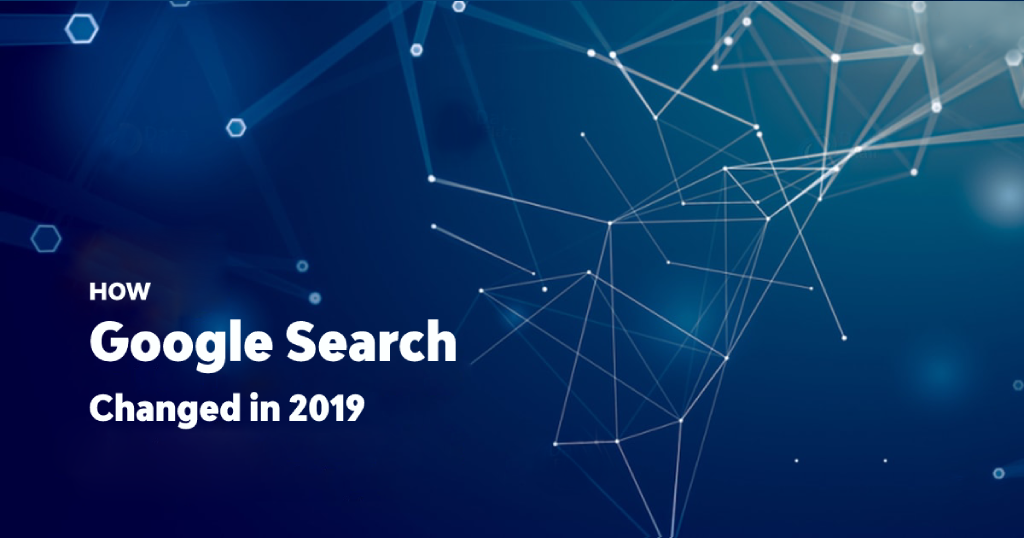
That being said, we’ve searched through our memories and the web to understand how Google has changed in 2019 so far and here are the top highlights:
- Pick up Where You Left off on Search
- Confirmed Broad Core Update in March
- New Way to Explore Information with Google Discover
- Enriching Search Results Through Structured Data
- Mobile-First Indexing by Default for New Domains
- The June 2019 Core Update
- The Site Diversity Update Roll Out
- Navigate the Search More Easily and Safer
Last year alone, Google performed 3,200 changes to their system, including features and regular updates meant to keep the results relevant. Moreover, they say evolution is the key to face the changes.
| “Sometimes the web just evolved. Sometimes what users expect evolves and similarly, sometimes our algorithms are, the way that we try to determine relevance, they evolve as well.” | |
| John Mueller | |
| Webmaster Trends Analyst at Google | |
1. Pick up Where You Left off on Search
Right at the beginning of the year, Google added a new feature that helped users who perform mobile searches and launched activity cards to help users pick up where they left off. For example, if you look for search queries such as clean eating receipts or clean eating diets and you are logged into your Google account, you’ll be able to find an activity card at the top of the results page. That way, it provides easy access and it is a handful way to continue exploring and read your previous searches.
You’ll only be able to see the pages you’ve visited, along with the searches you’ve made. You can either click on the pages that you viewed before or perform another search to discover other aspects to that topic. That way, you can pick up where you left off on Google search.
Moreover, you can bookmark a specific receipt and add it to your collection for future reference. Your collection can be accessed by looking in your menu on the top left of the Search page or through the bottom bar of Google app. You can have as many collections as you want.
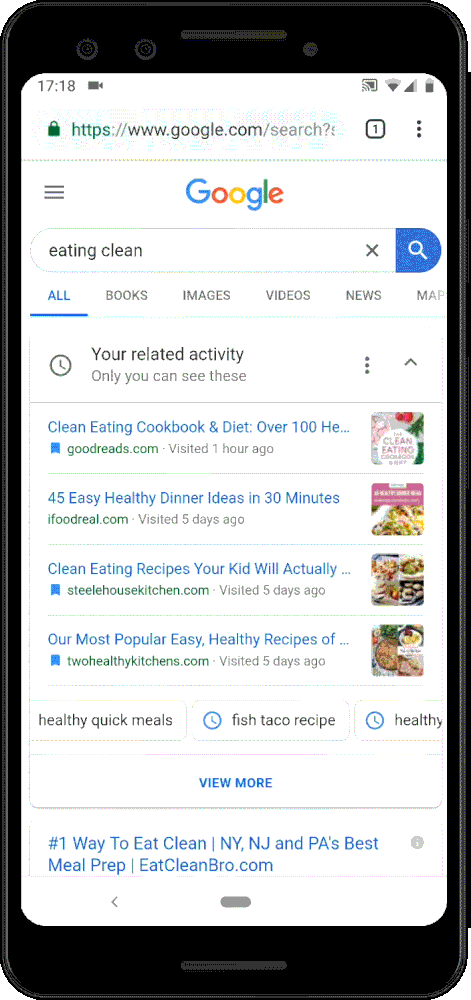
Easily edit your search activity and card by deleting pages or turning them off by tapping the three-dot icon.
The change performed by Google using this method was desired to make search history more accessible and more useful, help users follow their interests, build new habits, keep up with their tasks and keep valuable information on sight.
2. Confirmed Broad Core Update in March
The first confirmed update of this year from Google happened on March 13. Initially, the name was Florida 2.0, but Google themselves named this update Google March 2019 Core Update. The unlucky 13 came on a Wednesday.
The updates could be spotted using cognitiveSEO signals, by looking at the chart. In case there are big fluctuations, marked with red bars, that means there are possible updates. Below you can see a printscreen from the tool how the core update looked right on that day.
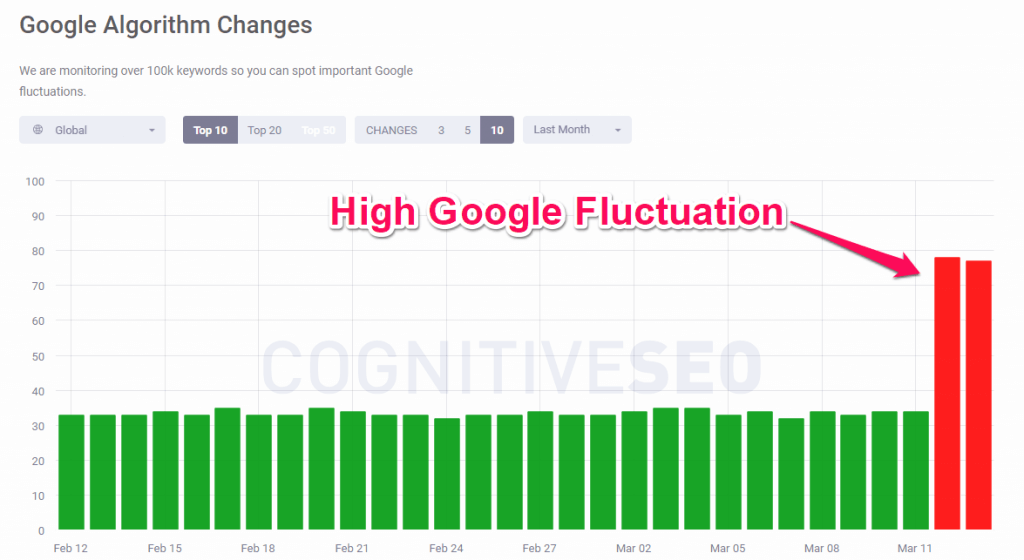
Google made it official on Twitter, where you can see the whole thread and the discussions on the topic:
This week, we released a broad core algorithm update, as we do several times per year. Our guidance about such updates remains as we’ve covered before. Please see these tweets for more about that: https://t.co/uPlEdSLHoXhttps://t.co/tmfQkhdjPL
— Google SearchLiaison (@searchliaison) March 13, 2019
While Google performs lots of focused updates nearly daily, there are some broad algorithm updates that happen several times per year. This update was about quality, designed to improve the overall results with no other specific details.
For every site that was impacted by that, there’s nothing they can do to fix it. Apparently, that’s what Google SearchLiaison said through a tweet. Building great content should be everyone’s mantra. Link building, social media marketing, online presence also matters in the SEO industry; so things remain the same.
| There’s no “fix” for pages that may perform less well other than to remain focused on building great content. Over time, it may be that your content may rise relative to other pages. | |
| Google SearchLiaison | |
Since content is mentioned, most probably it was a content related update, focusing on the quality it provides for the user. To stay ahead of competitors you should always search for the opportunity to deliver great content that becomes viral. Look for trends and evergreen content. With this in mind, ranking in Google will look like a gamble. Personalization and localization will become crucial and your focus will change upon that.
3. New Way to Explore Information with Google Discover
Named Google Feed when it was first released and later Google Discover a few months ago, the tool was planned to surface relevant content to the users, even when they’re not searching. The product is used by more than 800 million people each month to stay up to date.
Google Discover works very smoothly based on preferences, by following certain topics, customer’s behavior and search history. The tool recommends your content related to anything you might be interested such as sports, TV shows, actors, public personalities, brands, flights, travel, weather info and may more.

Google Discover can have major implications on how the user will interact with search and web. Since a user can personalize its search and select only the things that interest them, the Google Search itself might lose some of the popularity. With that in mind, a business will not compete to be in the first 10 positions to win the user’s heart, but rather in the top 1-3 (at max) because that is the number of results a user sees on a mobile screen when performing a search.
So, when a user searches for a topic, Google looks at the pattern for each user and tries to understand the subtopics related to each other. Based on the data collected, Google Discover will surface relevant topic that might interest the user next, predicting their future search.
Discover is one step ahead.
Discover has a lot of potential and it might change user behavior regarding online searching and information consumption.
4. Enriching Search Results Through Structured Data & Search Console
Google has always encouraged websites to add markup to their content for the search engines to understand better what that’s about. Implementing structured data on your website will probably offer you the chance to receive an enhanced appearance in Google search results.
In 2019, Google is pushing website owners to use more structured data for highlighting all sort of content and achieve more goals through a lot of great new features:
- Increase brand awareness: for logo, local business, and sitelinks search box.
- Markup your content for more traffic: for articles, breadcrumbs, events, jobs, Q&A, recipes, reviews.
- Highlight products on SERP for conversions: for price, availability, and review ratings.
Which such a big range of content that you can use structured data for, the SERP has definitely changed. The newest additions to the list are structured data for FAQ and “How-to” type of content. For example, “how-to” content can be highlighted, by adding structured data to the steps, tools, duration, and other properties. Take a look at the example below:
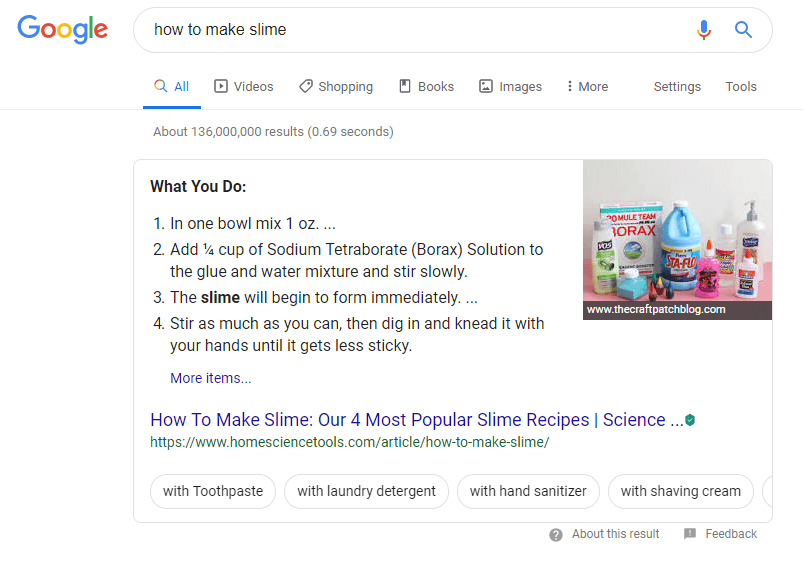
There is detailed how-to documentation and FAQ provided by Google to help you to perform a correct setup. Explore Google’s search gallery and look at the right documentation for each element.
Moreover, you can build how-to guides actions and FAQ answers with markup for Google Assistant, which means that how-to & FAQ answers can also be surfaced on the Google Assistant. Take a look at the example below:
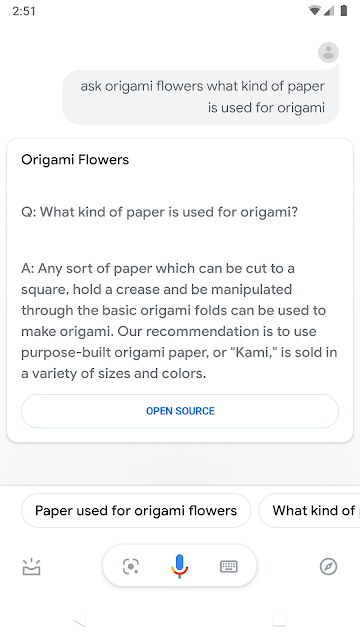
All the structured data can be supported both on Google Search and Google Assistant and in Search Console, where you can see reports and monitor your website’s performance.
In case there are some errors and Google Search Console detects some issues you’ll see them on the Enhancements report.
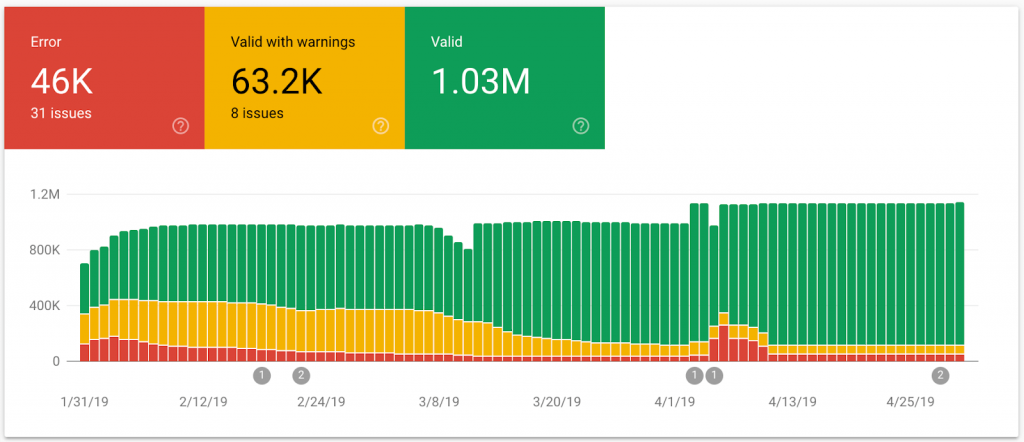
The Structured data reporting from GSC has lots of advantages and allows you to review errors, warnings and valid items, plus the pages associated with such issues.
5. Mobile-First Indexing by Default for New Domains
This year, at the end of May, Google announced that as of June 1, 2019 mobile-first indexing was enabled by default for all new websites. On that day, it became official that websites should present the same content to users and search engines for both mobile and desktop devices.
At the time we even wrote a 5 steps guideline to help website upgrade their mobile search engine optimization efforts and be prepared for the change.
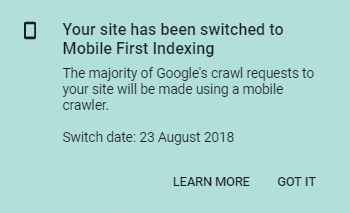
You can check any link from your website in Google Search Console using the URL Inspection Tool in Search Console. Doing so, you’ll see how it was crawled and indexed.
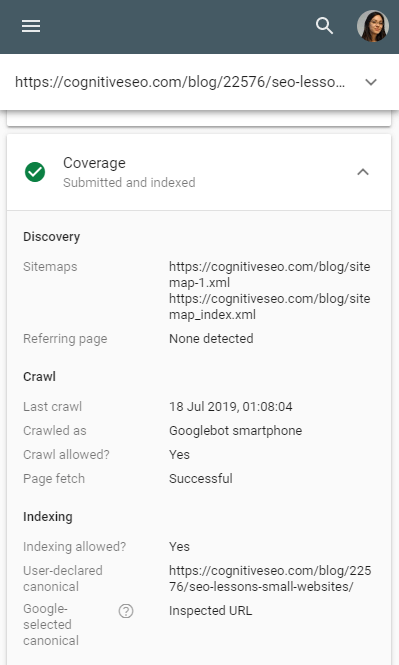
With this Mobile-First Indexing launching, Google search is changing, showing the same content on mobile and desktop, forcing sites to comply for them to keep their rankings (for both mobile and desktop). For newly designed websites Google is determining them to check factors such as parity of content (including text, images, videos, links), structured data, and other meta-data (such as titles and descriptions, robots meta tags) to comply with mobile-first indexing.
As mentioned before, Google recommends websites to be mobile friendly and keeps encouraging responsive web design. Since mobile-first indexing has been running websites, should use a single URL for both desktop and mobile websites.
6. The June 2019 Core Update
Google announced on Twitter that a core update was rolling out on June 3, 2019. Similar to the update from March, it is part of the several broad core algorithm updates.
Tomorrow, we are releasing a broad core algorithm update, as we do several times per year. It is called the June 2019 Core Update. Our guidance about such updates remains as we’ve covered before. Please see this tweet for more about that: https://t.co/tmfQkhdjPL
— Google SearchLiaison (@searchliaison) June 2, 2019
While Google hasn’t made any official statements on the following update, John Mueller said that core update encompasses a broader range of ranking factors. As he said, that there’s nothing specific to fix, lots of websites experienced ranking drops. You can hear what he specifically said in the Webmaster Central office-hours hangout when a user asked him about the update:
|
I think it’s a bit tricky because we’re not focusing on something very specific where we’d say like for example when we rolled out the speed update. (…)Sometimes the web just evolved. Sometimes what users expect evolves and similarly, sometimes our algorithms are, the way that we try to determine relevance, they evolve as well. |
|
| John Mueller | |
| Webmaster Trends Analyst at Google | |
He reminds about a blog post written by Amit Singhal, formerly the head of Google’s Search team for 15 years, about the quality of the website which can really help the users in situations like these.
To understand a little better the situation, use cognitiveSEO signals and look at the fluctuations. Below is a printscreen with the evolution of search when the Google update was released.
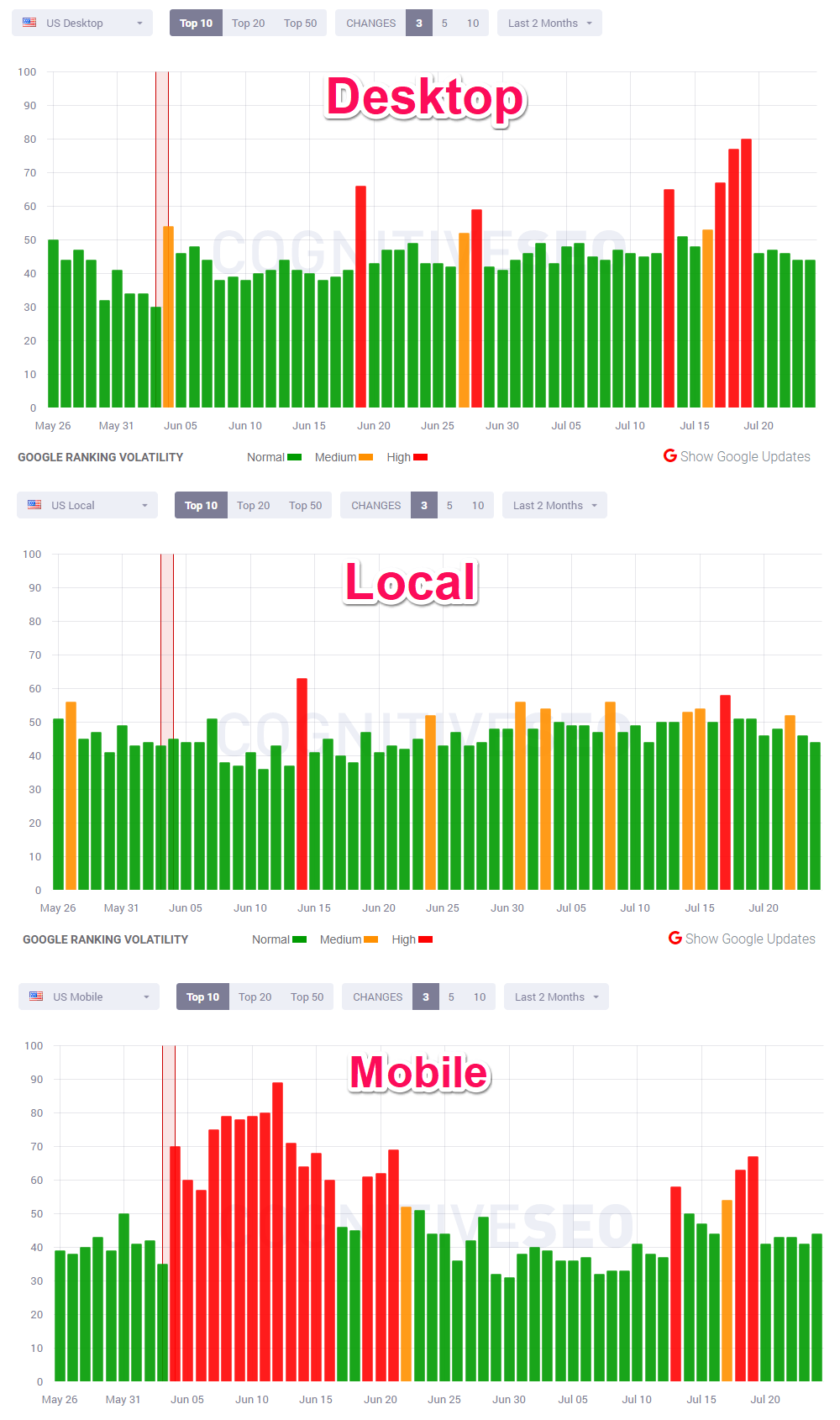
I looked for rankings changes for sites that had ranking changes by at least 3 positions on desktop, mobile and local rankings for the first page of Google Search Engine for the US market. cognitiveSEO signals monitor over 170.000 randomly selected keywords for both desktop, mobile and local rankings to offer valuable insights of what happens in Google so you can spot significant fluctuations.
7. The Site Diversity Update Roll Out
Right after the June 2019 Core Update, Google rolled out the Site Diversity update which is completely different and completely unrelated. This update was created in the interest of the user so they won’t see more than two listings from the same site in the top results. In the screenshot below you can see the top search results for “create dental website” where www.pbhs.com has two search results.
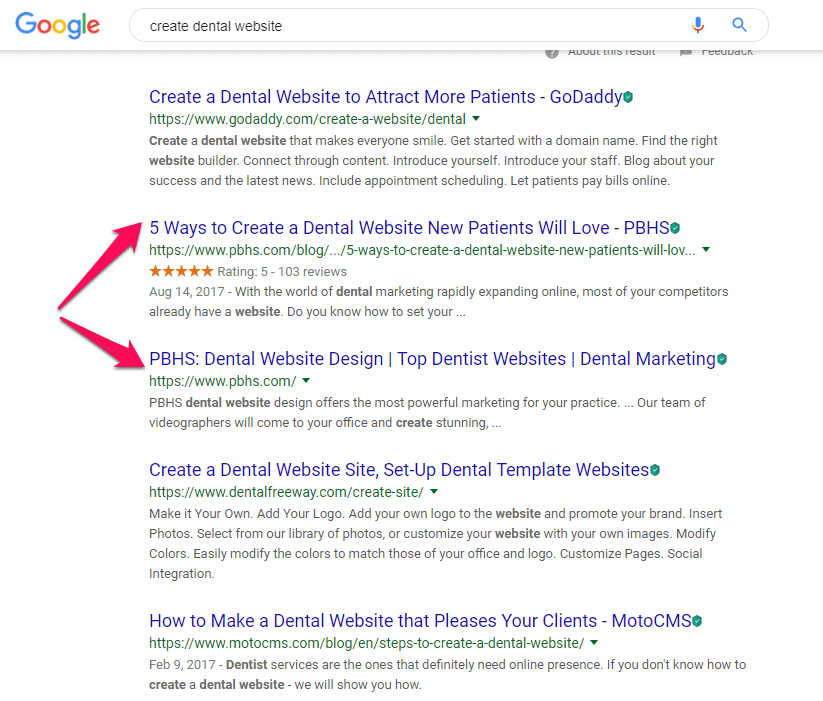
Google explains that there might be situations where you could see more than two search results in Google when their systems determine that it is relevant to do so for a particular search. Whether it is content, website speed, Rank Brain, conversion rate optimization or any other factor, Google’s algorithm will decide what to show. The good thing is that it is improving and refined in order to offer more relevant results.
This site diversity change means that you usually won’t see more than two listings from the same site in our top results. However, we may still show more than two in cases where our systems determine it’s especially relevant to do so for a particular search….
— Google SearchLiaison (@searchliaison) June 6, 2019
It will be a while maybe until this update works wanders because there are still people who see more than two results from a website in Google search engine’s top results, as you can see if you look people’s tweets.
Danny Sullivan, Google’s public Search Liaison, says will affect only main listings though:
Sounds like the diversity update will only affect regular organic results and not affect features like featured snippets, people also asks, etc. https://t.co/gFz1E1bhd4
— Marie Haynes (@Marie_Haynes) June 6, 2019
8. Navigate the Search More Easily and Safer
Continuing with diversity in SERP, Google wants to show more types of content including featured snippets with the results that might interest you, answers box, Knowledge Panels which can help you find key information or predict your searches using Autocomplete.
Their search results page doesn’t look like what we used to know, with a list of blue links and some ads. Now it is more personalized, offering information from lots of sources in all sorts of form: video content, visual content and text to connect you with useful information as quickly as possible.
If you look at the example below, you have lots of information above the fold allowing you to perform as fewest actions as possible and see everything with one click or two.
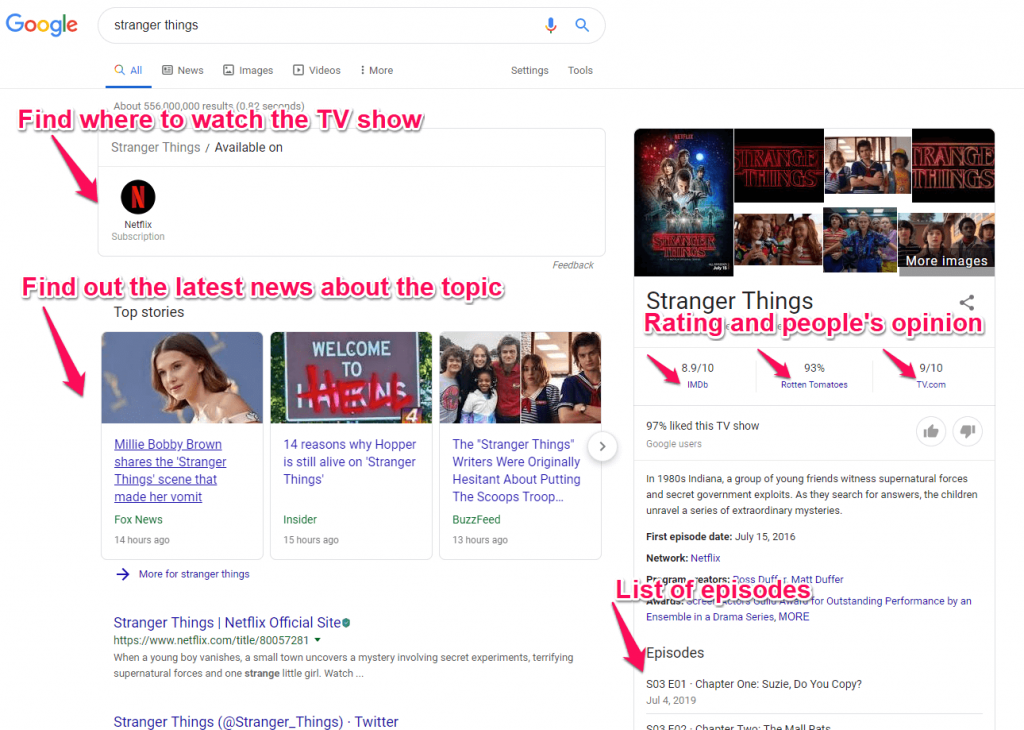
Takeaway
Ask for a new pair of eyes to look at your website to review it and find out new ways of improvement. Moreover, look together at who is searching through your website to find out what they are looking for, the flow. Evaluate user experience by looking at the user’s behavior. All these insights are a good exercise for you to understand the user better.
If the user is changing, their behavior will change, and therefore search will change. In this equation, your website should be changed -> improved. The search engine optimization role in the future of search gets even more complicated. Google for sure is shaping the future of SEO.

 Site Explorer
Site Explorer Keyword tool
Keyword tool Google Algorithm Changes
Google Algorithm Changes

My Bitdefender was blocking your article! Just wanted you to know that antivirus programs might be blocking you and running people off!
Many updates, and much fluctuation. SERP’s diversity will help with competitive results but I still see those with aggressive link building rank well with double, triple, quartriple indents. But by far much better.
Thanks Andreea!!
I think,here are the list of three biggest changes
you’ve seen in SEO within the last year or two:
1. Topic-based content clustering
In the past, content for SEO is simply using the target keyword(s) naturally within the content with a certain density. The same idea still applies today, but Google (and other search engines) are now smarter in determining whether a site is indeed relevant for a certain keyword and for the topic/niche that includes the keyword. So, today we will need a more holistic approach with our content, and we should develop more than one content pieces to cover a topic, establishing relevance.
2. Voice search
More and more people are using voice-based search queries either on their mobile devices or Amazon Alexa (and similar home assistant devices). Meaning, we should optimize for these “voice keywords” and since a huge majority of this voice search are with local intent (“near me” queries), local SEO for Google Maps ranking is now also a must, especially for local brick-and-mortar businesses.
3. Amazon Search
This is especially prevalent for e-commerce businesses. More and more people nowadays directly search on Amazon when looking for products, and so we can almost say that Amazon is the Google of e-commerce. SEO in Amazon require a relatively different approach, and will affect our overall strategy.
Any updates are done by google in this month?
Our site has dropped to 3rd page
Excellent post you shared here.